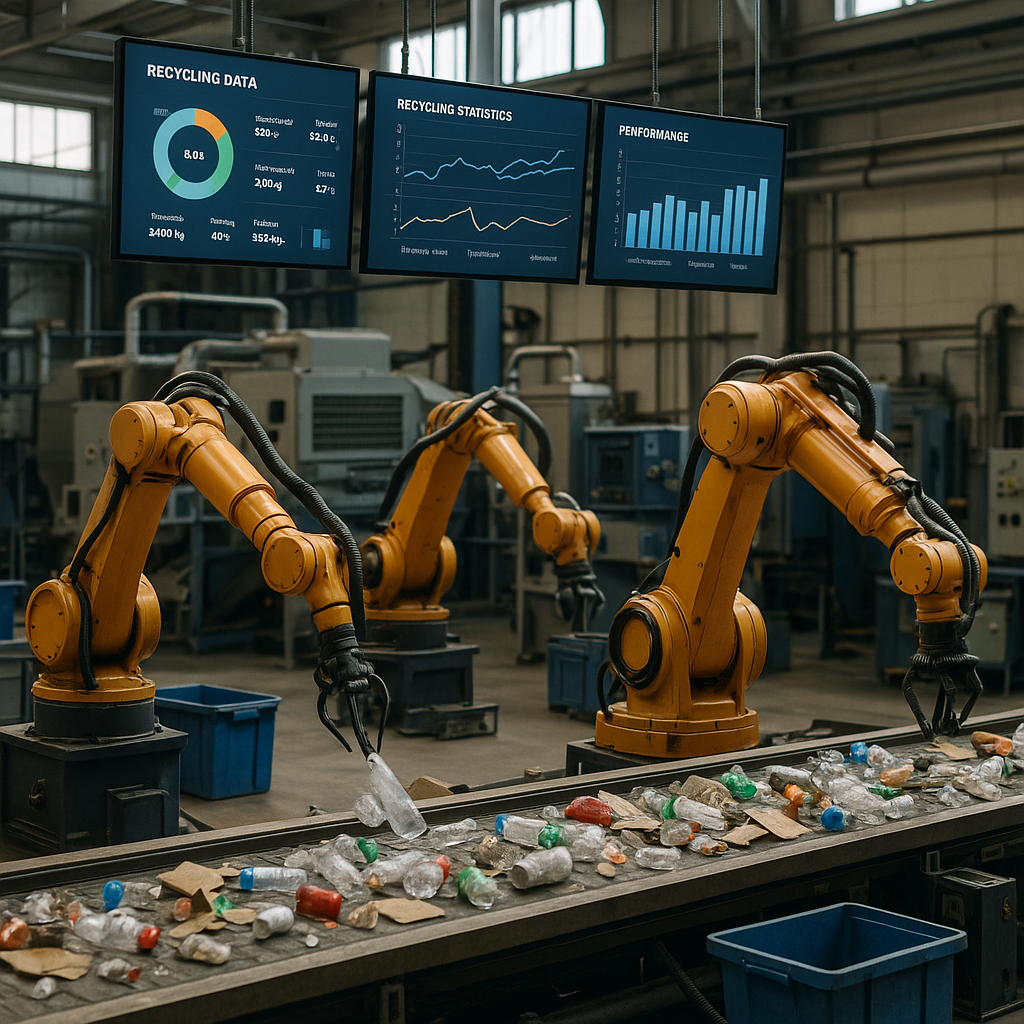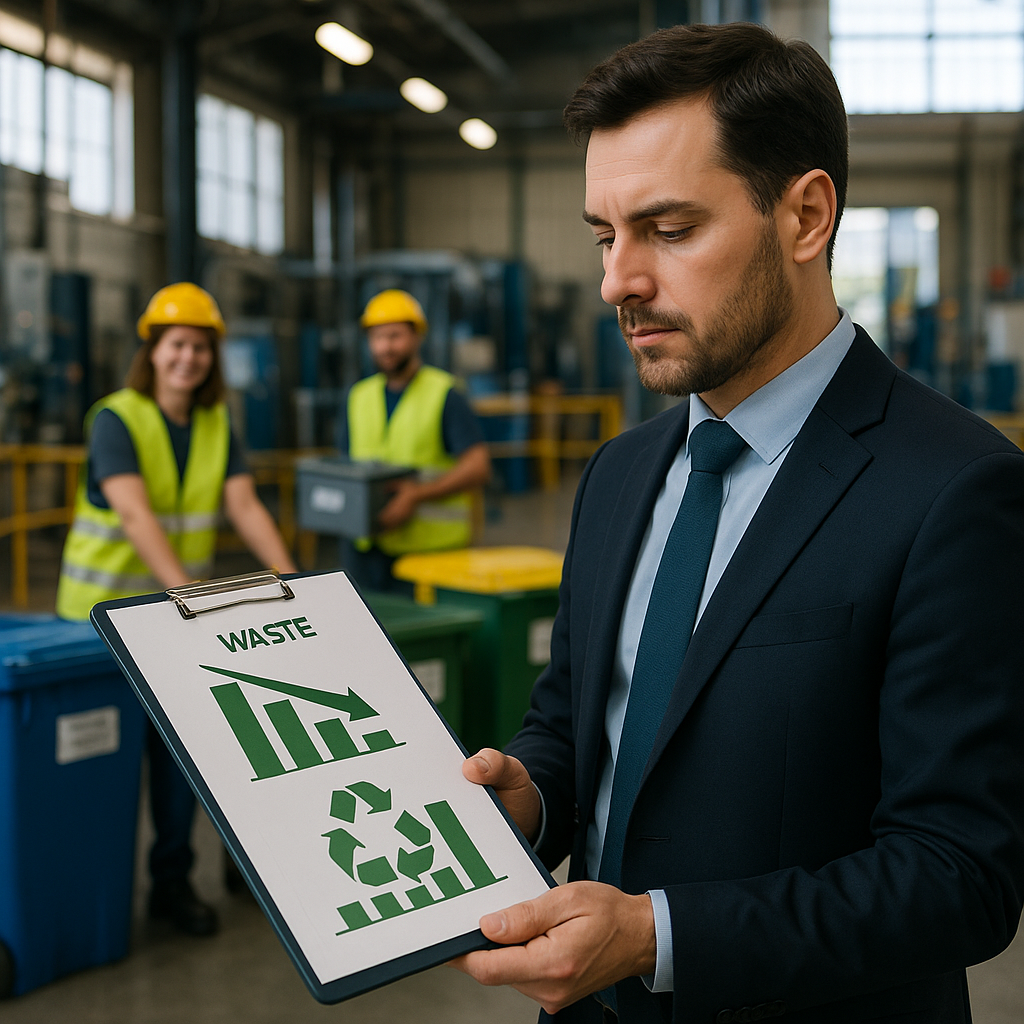5901 Botham Jean Blvd, Dallas, TX 75215
Learn the Industrial Recycling Best Practices
August 13, 2025Industrial recycling best practices represent systematic approaches that manufacturing facilities use to minimize waste generation and maximize resource recovery. These practices are essential in a world where raw materials are becoming increasingly scarce and expensive. The manufacturing sector generates billions of tons of waste annually, making efficient recycling systems vital for environmental protection and cost control.
Source reduction forms the foundation of effective industrial recycling. This involves redesigning production processes to create less waste from the start. Companies achieve this by optimizing manufacturing methods, using fewer raw materials, and enhancing equipment efficiency. The Environmental Protection Agency regards source reduction as the most effective way to minimize waste and its environmental impacts.
Reusing materials within industrial settings provides another powerful waste reduction strategy. Instead of discarding materials after a single use, facilities can repurpose them for different applications. For example, metal scraps from one process might serve as raw materials for another. This approach extends the useful life of materials and reduces the need for virgin resources.
How Can Companies Reduce Industrial Waste?

Industrial waste presents a significant environmental challenge for businesses across all sectors. Companies can implement several effective strategies to reduce waste generation, minimize environmental impact, and improve operational efficiency. The most successful approaches combine systematic process improvement with a commitment to resource optimization.
Just-in-Time Production Systems
Just-in-Time (JIT) production is an effective method for reducing industrial waste. This inventory management strategy aligns raw material orders with production schedules, receiving materials only when needed for manufacturing. Toyota pioneered this approach in the 1970s, showing how companies can operate with minimal inventory while maintaining production efficiency.
JIT systems reduce waste by eliminating excess inventory that might become obsolete or damaged in storage. This approach requires accurate demand forecasting and reliable supplier relationships. Companies implementing JIT can reduce warehouse space needs and associated costs while minimizing the risk of discarding unused materials.
Lean Manufacturing Principles
Lean manufacturing provides a framework for identifying and eliminating waste in production processes. The core principle focuses on delivering maximum value to customers using fewer resources. Companies that adopt lean principles systematically analyze their operations to eliminate non-value-adding activities.
The seven types of waste targeted in lean manufacturing include:
- Overproduction – Manufacturing items before they are needed
- Waiting – Idle time when work-in-process sits between production steps
- Transport – Unnecessary movement of materials within facilities
- Motion – Excess movement by workers due to poor workflow design
- Overprocessing – Performing more work than necessary for the required output
- Inventory – Excess materials, components, or finished goods beyond immediate needs
- Defects – Production errors requiring rework or disposal
By addressing these waste categories, companies can significantly reduce material consumption and waste generation. Value stream mapping helps identify waste hotspots, creating opportunities for targeted improvements.
Material Efficiency Strategies
Enhancing material efficiency reduces industrial waste by maximizing resource use. Companies can implement various approaches to improve how efficiently they utilize materials in production processes.
Effective material efficiency strategies include redesigning products to use fewer raw materials, implementing better material tracking systems, and optimizing cutting patterns to reduce scrap. Training employees to recognize material waste opportunities often leads to improvements, as front-line workers frequently identify practical solutions that management might overlook.
Material substitution can reduce waste by replacing hazardous or difficult-to-recycle materials with more environmentally friendly alternatives. This not only reduces waste disposal costs but also improves workplace safety and product marketability.
Source Reduction Through Supplier Partnerships
Collaborating with suppliers offers opportunities for waste reduction before materials enter production facilities. Source reduction focuses on minimizing waste at its origin rather than managing it after creation.
Companies can partner with suppliers to reduce packaging waste by requesting minimal or reusable packaging for incoming materials. Establishing packaging standards and return programs for shipping containers, pallets, and other transport materials creates closed-loop systems that prevent waste generation.
Supplier qualification programs with waste reduction criteria encourage innovation throughout the supply chain. Some companies have implemented vendor-managed inventory systems where suppliers maintain responsibility for optimizing material delivery and minimizing waste.
Manufacturing Process Modifications
Strategic modifications to manufacturing processes can dramatically reduce waste generation. Process optimization might include installing more efficient equipment, reconfiguring production lines to reduce material handling, or implementing automation for more precise operations.
Water and energy conservation measures reduce resource consumption while decreasing waste. Closed-loop systems that capture and reuse process water can significantly reduce both water consumption and wastewater generation. Similarly, heat recovery systems capture and repurpose energy that would otherwise be wasted.
Continuous improvement programs encourage ongoing refinement of manufacturing processes, creating a culture where waste reduction becomes standard practice. These programs empower employees to identify and implement incremental improvements that collectively produce substantial waste reductions.
What Are Effective Recycling Strategies for Industries?
Implementing effective industrial recycling strategies is essential for forward-thinking companies. The manufacturing sector generates substantial waste streams that, when properly managed, can create value rather than liabilities. Companies across various industries are adopting comprehensive recycling approaches that reduce environmental impact while improving operational efficiency.
One fundamental strategy is collecting and recycling scrap materials within the facility itself. This internal recycling loop minimizes transportation costs and keeps valuable resources onsite. For example, metal manufacturing facilities routinely collect metal shavings, off-cuts, and defective products to be melted down and reused in production. This practice reduces raw material costs and decreases waste disposal expenses.
Designing production processes with material recovery in mind represents another powerful approach. Closed-loop manufacturing systems intentionally create pathways for waste materials to return to the production cycle. The automotive industry demonstrates this principle through parts remanufacturing, where components like engines and transmissions are disassembled, cleaned, inspected, and rebuilt to original specifications. This process typically uses 85% less energy than manufacturing new parts.
Product take-back programs engage customers directly in the recycling ecosystem. Companies encourage customers to return used products for recycling or refurbishing through incentives like discounts on new purchases or free shipping for returns. Electronics manufacturers have pioneered this approach, with companies like Dell implementing programs that recover used computers and components for responsible recycling or refurbishment. These programs not only reduce waste but also strengthen customer relationships and brand loyalty.
The success of any industrial recycling strategy depends heavily on proper material handling techniques. Effective sorting methods are crucial, as contamination can significantly reduce the value of recyclable materials. Advanced sorting technologies like optical scanners, magnetic separators, and AI-powered robotics help ensure maximum material recovery and purity. Following sorting, washing processes remove contaminants that would otherwise compromise recycling quality, while size reduction techniques like shredding or grinding prepare materials for easier processing.
Material separation is a critical step in the industrial recycling process. This involves isolating different components of complex products to enable effective recycling of each material type. For example, automobile recycling facilities employ specialized equipment to separate plastics, metals, glass, and other materials from end-of-life vehicles. Without proper separation, many valuable materials would be lost to landfills.
Worker training plays an essential role in successful recycling operations. Employees need to understand proper waste segregation protocols, equipment operation, and safety procedures. Companies that invest in comprehensive training programs see higher material recovery rates and fewer workplace accidents. Regular refresher courses ensure that best practices remain top of mind for all personnel.
Continuous improvement through performance monitoring completes the picture. Leading companies track key metrics like material recovery rates, contamination levels, and processing costs to identify opportunities for enhancement. This data-driven approach allows for targeted improvements that maximize both environmental and economic benefits.
Beyond in-house recycling, many industries benefit from partnerships with specialized recycling facilities. These collaborations provide access to advanced processing technologies that may be impractical for individual companies to implement themselves. For instance, textile manufacturers often partner with specialized recyclers that can process fabric scraps into new fibers or alternative products like insulation materials.
How Can Technology Improve Industrial Recycling?

The industrial recycling landscape is undergoing significant technological advancements. Advanced digital solutions now allow manufacturers to track, sort, and process waste with precision and efficiency. These innovations represent fundamental shifts in how industries approach waste management and resource recovery.
IoT and Real-Time Monitoring in Waste Management
Internet of Things (IoT) technology has become transformative for industrial recycling operations. Smart sensors installed throughout facilities collect real-time data on waste volume, composition, and processing status. This continuous monitoring allows for immediate adjustments to operations rather than relying on periodic assessments.
The integration of IoT devices with cloud computing platforms enables interconnected recycling networks. These networks track materials from collection through processing, providing full visibility across the recycling supply chain. For example, waste containers equipped with fill-level sensors can automatically alert collection teams when they reach capacity, optimizing pickup routes and reducing unnecessary transportation.
Sensors that monitor equipment performance can detect potential failures before they occur, minimizing downtime and maintaining continuous recycling operations. This predictive maintenance approach has helped several large facilities reduce operational interruptions by up to 30%.
Enhancing Material Recovery with Advanced Sorting Technologies
Traditional sorting methods often struggle with mixed waste streams, leading to contamination and lower-quality recycled materials. Modern sorting technologies address this through automated systems that identify and separate materials with remarkable accuracy.
Optical sorting systems use high-resolution cameras and near-infrared spectroscopy to identify different types of plastics, even those with similar appearances. These systems process materials at rates exceeding 8 tons per hour with recognition accuracy above 95% for most common materials.
Artificial intelligence and machine learning algorithms continually improve sorting accuracy by learning from mistakes. Advanced systems can now distinguish between dozens of different plastic types and colors, significantly expanding the range of materials that can be effectively recycled.
3D Printing and the Reshaping of Product Design
3D printing is reshaping industrial recycling by enabling more sustainable product design and manufacturing processes. The additive nature of 3D printing creates objects by adding material only where needed, resulting in significantly less waste compared to traditional manufacturing methods that often remove material.
Beyond waste reduction in manufacturing, 3D printing offers promising applications for recycled materials. Several companies now produce 3D printing filament made from recycled plastics, creating a circular pathway for materials that might otherwise end up in landfills. This approach is particularly valuable for hard-to-recycle plastics that conventional systems struggle to process.
For industrial operations, 3D printing enables on-demand production of replacement parts, reducing the need for large inventories and the associated waste when parts become obsolete. This just-in-time manufacturing approach minimizes storage requirements and extends the functional life of existing equipment.
Optimizing with Data Analytics
Data analytics is transforming how recycling facilities operate. By analyzing patterns in waste generation, processing efficiency, and market demand, facility operators can make informed decisions to optimize their operations.
Predictive analytics help facilities anticipate fluctuations in waste volume and composition, allowing them to adjust staffing and processing capacity accordingly. These insights enable more efficient resource allocation and higher throughput during peak periods.
Blockchain technology is beginning to play a role in recycling by creating secure, transparent records of material flows. It helps verify the origin and processing history of recycled materials, building trust and potentially increasing their market value.
Practical Applications and Results
The integration of these technologies delivers measurable improvements in recycling efficiency. Facilities using advanced sorting technologies report recovery rate increases of 15-25% compared to conventional systems, directly increasing materials diverted from landfills and returned to productive use.
Energy consumption in technology-enhanced facilities has decreased by up to 20% through optimized processes and equipment utilization. This reduction improves the environmental benefit of recycling while lowering operational costs.
The quality of recovered materials has improved substantially, with contamination rates dropping by as much as 40% in facilities using multi-stage automated sorting. Higher-quality recycled materials command better prices and can be used in more demanding applications, strengthening the economic case for recycling.
As technology continues to evolve, it promises to address many persistent challenges in industrial recycling. The combination of real-time monitoring, advanced sorting, sustainable manufacturing, and data-driven optimization creates a powerful toolkit for industries seeking to maximize resource recovery while minimizing environmental impact.
What Are the Benefits of Implementing Industrial Recycling Best Practices?

Implementing industrial recycling best practices provides substantial value beyond mere environmental stewardship. Companies prioritizing effective waste management and material recovery gain competitive advantages while contributing to a sustainable future.
The most immediate benefit is cost reduction. By recycling materials such as metal, paper, and plastic, businesses can significantly lower their disposal costs. The EPA reports that recycling and reuse activities generate billions in tax revenue and support hundreds of thousands of jobs nationwide. Companies can also decrease expenses by using recycled raw materials, which often require less energy to process than virgin resources.
Environmental benefits are equally significant. Industrial recycling reduces landfill waste, conserves natural resources, and decreases greenhouse gas emissions. Research shows recycling aluminum uses 95% less energy than producing it from raw materials. These practices help companies minimize their carbon footprint and support the global shift to a circular economy.
For any modern business, regulatory compliance is crucial. Industrial recycling aids companies in meeting increasingly stringent environmental regulations, avoiding potential fines and legal issues. Moreover, businesses with strong sustainability practices enhance their corporate image, fostering stronger relationships with environmentally conscious customers, partners, and communities.
If your business generates industrial waste, now is the time to evaluate your recycling practices. Contact Okon Recycling at 214-717-4083. Our team can help you develop efficient recycling strategies tailored to your industry needs, transforming waste challenges into opportunities for both environmental and economic benefits.
